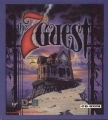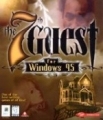The 7th Guest
First posted on 25 September 1997. Last updated on 05 December 2013.

|
| The 7th Guest is among the bestselling games in the early CD-ROM era. |

|
| The eerie Stauf mansion is beautifully rendered. |

|
| The omnipotent Stauf plots revenge on his guests. |
In the dawn of the CD-ROM era, a little known company named Trilobyte sets off to develop a software that aims to harness the capacity of the CD-ROM to deliver the multimedia capability of the home computer. The end result is the market hit called The 7th Guest. With its incredible graphics and sound effects, The 7th Guest is considered to be the "killer app" that heralds in the market for CD-ROM technology. Countless CD-ROM drives have been sold bundled with this software to show off the capability of the device. Yet, to some veteran gamers who see through the hype it has generated, the game mounts to little more than a disjointed collection of classic logic puzzles disguised in pretty packages. Whether this title should be praised for its achievement or damned for its failure, there can be no argument that The 7th Guest has written itself onto a page in the computer gaming history.
Henry Stauf is an enigmatic drifter who creates a toy making empire 70 years ago by suddenly developing a gift to craft incredible toys from his dreams. "A Stauf toy is a toy for life" has become a legend in itself. Yet reclusive, this wealthy but twisted toy maker invited 6 guests one night to a party at his hilltop estate, promising to fulfill their desires for great wealth or power. No one has seen or heard from these guests since that night. After 70 years while visiting the now deserted mansion, you are suddenly transported back in time as an entity known as Ego, only to witness the cold-blooded murders of these guests on that fatal night! The tales of their deaths appear to revolve around a mysterious "7th Guest". The identity of this guest is finally revealed when the evil Stauf and his sinister puzzles are defeated.The 7th Guest has been hailed as a technological marvel in game graphics and sounds for its time. High resolution SVGA graphics detail the mansion's 22 rooms. Pre-rendered Full Motion Videos are used to animate the transition between locations. The soundtrack is scored by George Alistair Sanger who is also known as The Fat Man. The second disc also contains the entire musical score that can be played as a conventional audio CD. The original release runs in DOS. The 7th Guest For Windows 95 is a revamped release which provides native Windows 95 support; the game is otherwise identical to the original.
Navigation through the game is controlled by pointing and clickomg using an animated skeleton hand cursor. A map is available to depict the different locations that are accessible as the game progresses. A hotspot denotes place of significance or presence of a puzzle. Gameplay involves solving a series of logic puzzles. Success in solving a puzzle is then rewarded by a video clip that advances the plot. The final confrontation with the evil Stauf takes place through a game of strategy against the artificial Intelligence.
There can be no argument that the graphics in The 7th Guest are breathtaking to watch. The ambience soundtrack is likewise absorbing. The taunting voice of Stauf, who is played by Robert Hirschboeck, is eerie! Each puzzle is beautifully animated, bringing a fresh face to some of the old classic brainteasers. An added twist is that the rules to these puzzles are not given. One needs to experiment with the behavior of each puzzle to understand its nature. A Book of Clues is available in the Library that offers hints and even solves the puzzles if the player is hopelessly stuck. Once the player successfully finishes the game to its conclusion, an "Open House" mode will be made available that allows the player to revisit any of the puzzles at one's leisure.
The 7th Guest has difficulty in convening a succinct story. The multiple disjointed videos played between puzzles are confusing, leading to an even more confusing ending that is frankly anticlimactic. The puzzles are not well integrated into the story. All the puzzles are merely rehashes of classic puzzles found elsewhere. Although the animations of these puzzles may be fun to watch at first, they go tiresome quickly after being replayed over and over again. An option to turn off the animation will be appreciated. This criticism also applies to the slow and repetitive animations of the transition scenes when one is roaming about the house. Replay value is minimal once all the puzzles have been solved.
The 7th Guest has written itself into the history book as the "killer app" that hails the introduction of CD-ROM technology. It is a graphical adventure extravaganza but fails to deliver a succinct story and original puzzle play. Who wants to be The 7th Guest?

